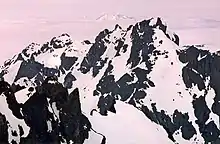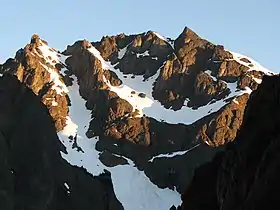Inner Constance
Inner Constance is a summit of the Olympic Mountains and is located in Jefferson County of Washington state. It's located near the eastern edge of Olympic National Park on the Olympic Peninsula. At 7,667 feet (2,337 m) high, Inner Constance is the fifth highest peak of the Olympic Mountains, after Mount Olympus, Mount Deception, Mount Constance, and Mount Johnson.[1] Its nearest higher peak is Mount Constance at 0.9 mi (1.4 km) to the east.[1] Within this nearly mile-wide separation resides a deep glacially carved canyon called Avalanche Canyon. Precipitation runoff on the north side of the peak drains into tributaries of the Dungeness River, whereas the south side drains into tributaries of the Dosewallips River.
| Inner Constance | |
|---|---|
 Inner Constance seen from Mount Constance | |
| Highest point | |
| Elevation | 7,680 ft (2,340 m) [1] |
| Prominence | 1,147 ft (350 m) [1] |
| Coordinates | 47°46′12″N 123°08′47″W [1] |
| Geography | |
 Inner Constance Location of Inner Constance in Washington  Inner Constance Inner Constance (the United States) | |
| Location | Jefferson County, Washington, United States |
| Parent range | Olympic Mountains |
| Topo map | USGS Mount Deception |
| Geology | |
| Age of rock | Eocene |
| Type of rock | Tilted pillow Basalt |
| Climbing | |
| First ascent | 1939, David Harrah and party[2] |
| Easiest route | Climbing |
Climate
Inner Constance is located in the eastern portion of the Olympic Mountains. This location results in less precipitation than Mount Olympus and the western Olympics receive. Inner Constance is located in the marine west coast climate zone of western North America.

Most weather fronts originate in the Pacific Ocean, and travel northeast toward the Olympic Mountains. As fronts approach, they are forced upward by the peaks of the Olympic Range, causing them to drop their moisture in the form of rain or snowfall (Orographic lift). As a result, the Olympics experience high precipitation, especially during the winter months in the form of snowfall. During winter months, weather is usually cloudy, but, due to high pressure systems over the Pacific Ocean that intensify during summer months, there is often little or no cloud cover during the summer. Because of maritime influence, snow tends to be wet and heavy, resulting in high avalanche danger.
Geology
The Olympic Mountains are composed of obducted clastic wedge material and oceanic crust, primarily Eocene sandstone, turbidite, and basaltic oceanic crust.[3] The mountains were sculpted during the Pleistocene era by erosion and glaciers advancing and retreating multiple times.

References
- "Inner Constance". Peakbagger.com.
- "First Ascents - Climbers Guide to the Olympic Mountains". climbersguideolympics.com. Retrieved 2018-07-31.
- Alt, D.D.; Hyndman, D.W. (1984). Roadside Geology of Washington. pp. 249–259. ISBN 0-87842-160-2.
External links
- "Olympic National Park". National Park Service.